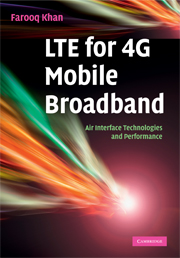Book contents
- Frontmatter
- Contents
- Preface
- 1 Introduction
- 2 Network architecture and protocols
- 3 Downlink access
- 4 Single-carrier FDMA
- 5 Reducing uplink signal peakiness
- 6 Transmit diversity
- 7 MIMO spatial multiplexing
- 8 Channel structure and bandwidths
- 9 Cell search and reference signals
- 10 Random access
- 11 Channel coding
- 12 Scheduling, link adaptation and hybrid ARQ
- 13 Power control
- 14 Uplink control signaling
- 15 Downlink control signaling
- 16 Inter-cell interference control
- 17 Single frequency network broadcast
- 18 Spatial channel model
- 19 LTE performance verification
- Index
8 - Channel structure and bandwidths
Published online by Cambridge University Press: 28 February 2011
- Frontmatter
- Contents
- Preface
- 1 Introduction
- 2 Network architecture and protocols
- 3 Downlink access
- 4 Single-carrier FDMA
- 5 Reducing uplink signal peakiness
- 6 Transmit diversity
- 7 MIMO spatial multiplexing
- 8 Channel structure and bandwidths
- 9 Cell search and reference signals
- 10 Random access
- 11 Channel coding
- 12 Scheduling, link adaptation and hybrid ARQ
- 13 Power control
- 14 Uplink control signaling
- 15 Downlink control signaling
- 16 Inter-cell interference control
- 17 Single frequency network broadcast
- 18 Spatial channel model
- 19 LTE performance verification
- Index
Summary
A major design goal for the LTE system is flexible bandwidth support for deployments in diverse spectrum arrangements. With this objective in mind, the physical layer of LTE is designed to support bandwidths in increments of 180 kHz starting from a minimum bandwidth of 1.08 MHz. In order to support channel sensitive scheduling and to achieve low packet transmission latency, the scheduling and transmission interval is defined as a 1 ms subframe. Two cyclic prefix lengths namely normal cyclic prefix and extended cyclic prefix are defined to support small and large cells deployments respectively. A subcarrier spacing of 15 kHz is chosen to strike a balance between cyclic prefix overhead and robustness to Doppler spread. An additional smaller 7.5 kHz subcarrier spacing is defined for MBSFN to support large delay spreads with reasonable cyclic prefix overhead. The uplink supports localized transmissions with contiguous resource block allocation due to single-carrier FDMA. In order to achieve frequency diversity, inter-subframe and intra-subframe hopping is supported. In the downlink, a distributed transmission allocation structure in addition to localized transmission allocation is defined to achieve frequency diversity with small signaling overhead.
Channel bandwidths
The LTE system supports a set of six channel bandwidths as given in Table 8.1.We note that the transmission bandwidth configuration BWconfig is 90% of the channel bandwidth BWchannel for 3–20 MHz. For 1.4 MHz channel bandwidth, the transmission bandwidth is only 77% of the channel bandwidth. Therefore, LTE deployment in the small 1.4 MHz channel is less spectrally efficient than the 3 MHz and larger channel bandwidths.
- Type
- Chapter
- Information
- LTE for 4G Mobile BroadbandAir Interface Technologies and Performance, pp. 172 - 186Publisher: Cambridge University PressPrint publication year: 2009



